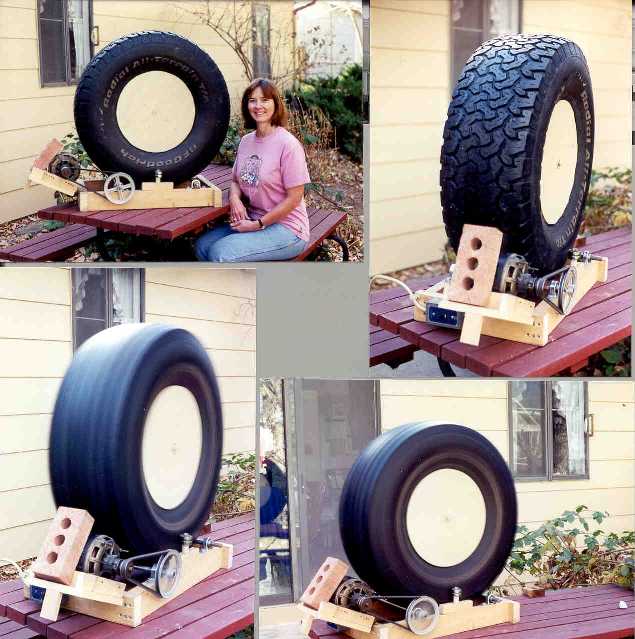The bottom two photos are one-second exposures of the tumbler in operation (empty). If you think the splashguard is well camouflaged against the house behind it, that's because I used the same (leftover) latex paint on the splashguards as was used on the house. :-)
After several months of operation, mainly overnight only, my tumbler is producing an average of just over 10 pounds of rock ready-to-polish every 6 days, about 3 times as fast as a Lortone 12-pound barrel tumbler in constant operation. I spend about 1.5 hours managing it (not including cleaning up slurry spilled on my back porch :-) for that amount of rock, or about nine minutes per pound of rock. It consumes about $0.93 of grit per day, compared to $0.15 of electricity. And it does all this while the tire runs at just 0.78 MPH (1.26 KPH) :-)
The tire is actually showing signs of wearing out... From the inside...
I gotta point the BF Goodrich folks at this site for their amusement. Unfortunately, Goodrich was bought out by Michelin some years ago, and the Michelin website seems to offer no way to contact them...
Alan Silverstein

Date: Tue, 15 Feb 2000 10:00:31 -0700 (MST)
From: Alan Silverstein ajs@frii.com
Subject: big tumbler -- news
For those of you following the saga of my fifty pound rock tumbler (see http://www.acc.umu.se/~widmark/lwtrumld.html, here's some news...
* I wore out my first tire! (Size 33x12.5R15.) It took only about three months of nightly operation, all with coarse grit. Over several weeks flakes of rubber showed up in the slurry and the rocks stopped rolling. They just slid, no matter how many/few rocks or how much/little grit or water I used.
Inside the tire I could see horizontal streaks, across the direction of motion, where the belts were showing. About 50% of the surface was white. It still felt ribbed and rough, but apparently the butyl rubber lining is significant at a microscopic scale to give "traction" to the rock/grit mix.
I rolled the tire up to the door at the dealer. "It's worn out... On the inside." "Yup, it sure is, those are belts showing." They were amused.
* I borrowed another used tire from my tire dealer, but all they had on the recycle pile at the time was a 31x10.5R15. This has only 70% of the capacity of my first tire, but the splashguards transferred OK since the wheel size was the same. Trying this new (old) tire proved the problem was the old tire and nothing else.
* The new tire wobbled a lot on my tumbler base, to the point it would fall over. Either width matters (an extra 2" DOES make a difference :-) or the new tire was less evenly worn than the previous one. Regardless, I addressed this by using 9 pieces of wood, 24 screws, 4 washers, and 4 rollerblade bearings to build a removable frame over the top of the tire, to put side guide roller bearings at the top of it, not just at the bottom.
I suppose that, first, I will have to get in the habit of "borrowing" tires from my dealer's recycle pile, wearing out their insides, and returning them; and second, I should revise my writeup sometime with this new information.
Alan Silverstein